Butterflies and moths vary in color, appearance, behavior, wing structure, and pupae.
During my school days, our teachers would often take us on nature walks. These excursions would cover the entire expanse of our campus, which was essentially a forest. We would encounter various creatures like birds, turtles, lizards, frogs, and beetles, but it was the butterflies that fascinated us youngsters the most. They came in all sizes, ranging from small to large, and in an array of vibrant colors.
One particular instance stands out in my memory, when I stumbled upon a butterfly resting on a leaf. It had a light green hue with a touch of white and was approximately the size of my palm. I distinctly remember standing there, marveling at its tranquility and elegance even in its state of repose. It was the most exquisite creature I had ever laid eyes on.
I hurriedly went to my environmental science teacher, who was quite knowledgeable about butterflies, and beseeched her to identify it for me. To my astonishment, she informed me, “This is not a butterfly, it’s a moon moth.”
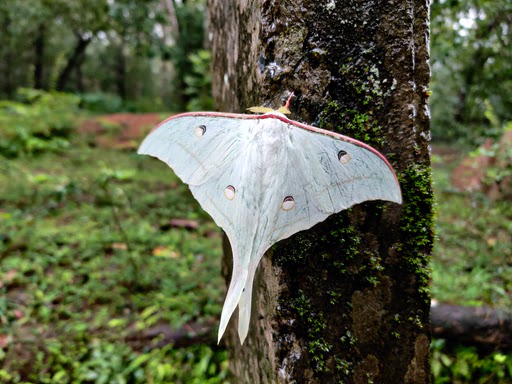 Can you imagine how easy it is to mistake moths for butterflies when they resemble this? (Photo Credit : Rajendra Bhat/Shutterstock)
Can you imagine how easy it is to mistake moths for butterflies when they resemble this? (Photo Credit : Rajendra Bhat/Shutterstock)
As a young student, I was perplexed. How could this insect be a moth when it looked identical to a butterfly? The rest of the day was spent in my attempt to distinguish between the two.
As evident, distinguishing between butterflies and moths can be quite challenging. It is therefore important for you to remember that although both are insects, they differ significantly from one another. Before delving into their dissimilarities, let’s briefly examine butterflies and moths.
Characteristics of Butterflies And Moths
Butterflies and moths belong to the same order Lepidoptera, a Greek term meaning “scales” and “wings”. Both possess unique features, such as coiled proboscis (mouthparts) and large wings, which set them apart from other insects. Interestingly, their bodies, wings, and legs are covered in scales, which transfer onto anything that comes into contact with them. These insects can be found all over the world, excluding Antarctica.
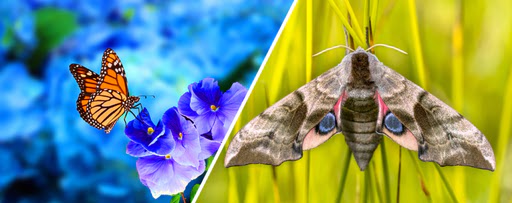 (L) Butterfly, (R) moth. Can you spot any differences? (Photo Credit : Candy_Plus & Rudmer Zwerver/Shutterstock)
(L) Butterfly, (R) moth. Can you spot any differences? (Photo Credit : Candy_Plus & Rudmer Zwerver/Shutterstock)
How Are They Formed?
The process of development for moths and butterflies is called metamorphosis, which consists of four stages of life: egg, larva (caterpillar), pupa, and adult. The adult females lay eggs on plants in the egg stage, which serve as food for the later hatched caterpillars. Once the caterpillars hatch, their sole purpose is to eat and gain as much nutrition as possible before transforming into a pupa.
The pupa can be concealed under leaves, buried underground, or suspended from branches, depending on the species of insect. Inside the pupa, it may take weeks or even months for them to grow. Gradually, their cells transform into wings, eyes, legs, antennae, and other parts of the butterfly. Eventually, the pupa becomes a fully developed adult with legs, eyes, and a body. The transformation from egg to adult is relatively long compared to its overall lifespan. However, most butterflies and moths live for only a week or two, although some can live for several months.
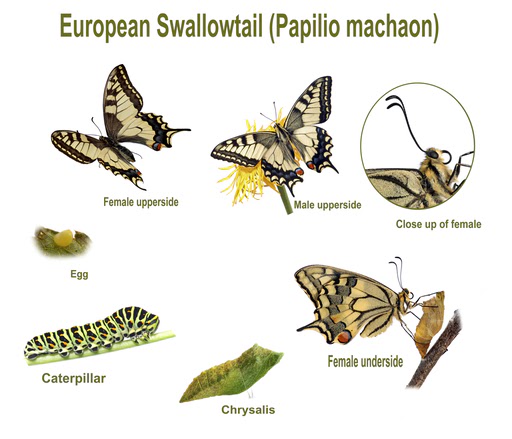 The process of metamorphosis is similar in both moths and butterflies. (Photo Credit: jps/Shutterstock)
The process of metamorphosis is similar in both moths and butterflies. (Photo Credit: jps/Shutterstock)
Now, let’s delve into the interesting details of how they differ from each other!
Differences Between Butterflies And Moths
Active Hours
The most noticeable difference between these two insects is their activity patterns. Butterflies are diurnal, meaning they are active during the day, while moths are nocturnal, meaning they are active at night. So, the next time you spot an insect sipping nectar from a flower on a hot summer afternoon, you can confidently inform your friends that it’s a butterfly.
Color
The next distinct difference is their coloration. Butterflies are much more vibrant in color compared to moths. They have bright colors and intricate patterns on their bodies. Moths, on the other hand, are usually dull and less vibrant. Butterflies exhibit a wide range of colors, but there are exceptions. For example, both the northern Queensland Day moth (Alcides metaurus) and Jacob’s Coat moth (Agarista Agricola) are exceptionally bright for moths.
 As you can see, butterflies are much more vibrant than moths. (Photo Credit: Shubhrojyoti & Melinda Fawver/Shutterstock)
As you can see, butterflies are much more vibrant than moths. (Photo Credit: Shubhrojyoti & Melinda Fawver/Shutterstock)
Wings At Rest
When moths rest on plants, they keep their wings spread wide open. On the other hand, butterflies rest with their wings closed. However, there are times when you may see butterflies with their wings open while sunbathing. Interestingly, like us humans, butterflies also need their daily dose of vitamin D to regulate their body temperature. Therefore, most mornings when you see them basking in the sun, they are actually trying to increase their body heat.
Physical Appearance, Size, And Wing Structure
Moths are bulkier and more hairy than butterflies, who are generally slimmer and smoother. Moths are also much smaller in size compared to butterflies. Moths have a structure called the frenulum, which connects their front and hind wings, while butterflies do not have this structure.
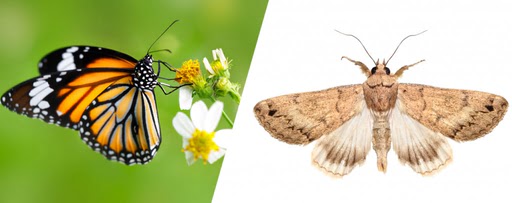 Butterflies have a slimmer body compared to moths. (Photo Credit : Patrick Foto & Protasov AN/Shutterstock)
Butterflies have a slimmer body compared to moths. (Photo Credit : Patrick Foto & Protasov AN/Shutterstock)
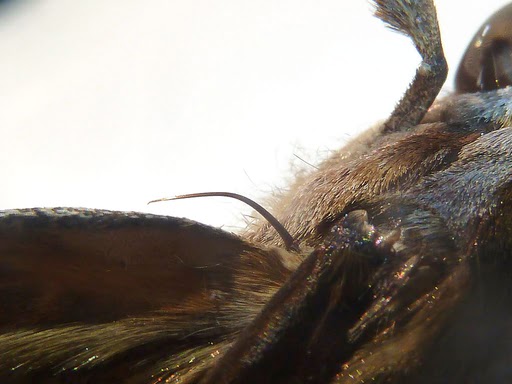 Male hawkmoths have a single frenulum made up of several bristles, which can only be seen when their forewings are pulled back. (Photo Credit : JMK/Wikimedia Commons)
Male hawkmoths have a single frenulum made up of several bristles, which can only be seen when their forewings are pulled back. (Photo Credit : JMK/Wikimedia Commons)
Pupae
Both of these insects go through the pupa stage during metamorphosis. Butterflies create a pupa made of hardened protein, while moth caterpillars spin a silk cocoon.
 (Left) Butterfly pupa and (Right) Moth pupa (Photo Credit : Leena Robinson & MagicBones/Shutterstock)
(Left) Butterfly pupa and (Right) Moth pupa (Photo Credit : Leena Robinson & MagicBones/Shutterstock)
Antennae
Butterflies have wide antennae, especially at the tips, and they also have a club or hook at the end. Moths, on the other hand, have thread-like and feathery antennae without clubbed tips.
What Role Do These Insects Play?
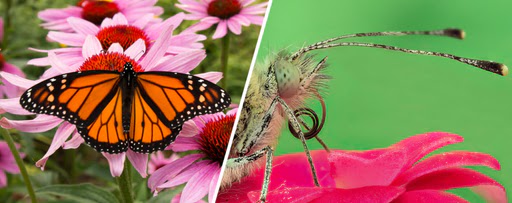 Both moths and butterflies play a crucial role in pollination, which is the biggest and most important role they have. (Photo Credit : Media Marketing & Cornel Constantin/Shutterstock)
Both moths and butterflies play a crucial role in pollination, which is the biggest and most important role they have. (Photo Credit : Media Marketing & Cornel Constantin/Shutterstock)
Although there are many differences between butterflies and moths, they both have significant roles in our ecosystems. Firstly, they have aesthetic value as they represent beauty, peace, and eco-friendliness. Secondly, they have scientific value and have been used as model organisms for studies on navigation, genetics, population dynamics, and pest control. Thirdly, they are valuable to our ecosystems as they aid in pollination, serve as prey for insectivorous animals, and act as indicators of healthy ecosystems. Fourthly, their interesting life cycles make them ideal for teaching children about the natural world. Fifthly, like other animals and insects, both moths and butterflies contribute to economic income through butterfly gardens and observatories. Lastly, and most importantly, like every other creature on this planet, they deserve the right to live!
